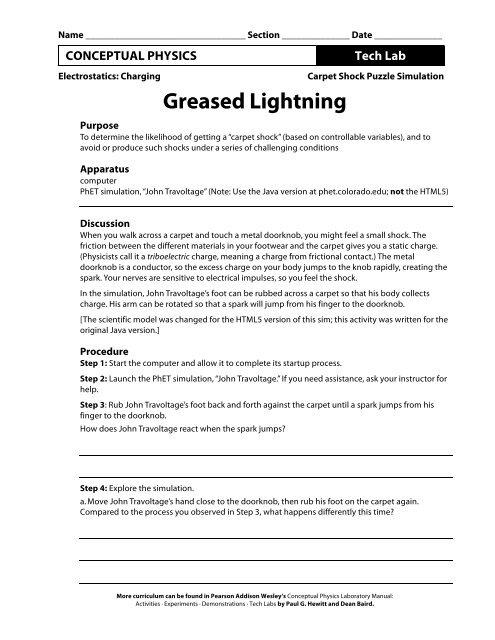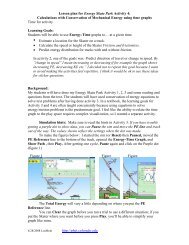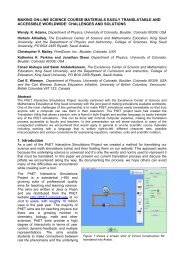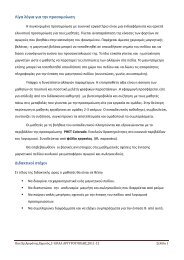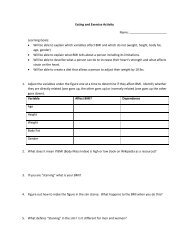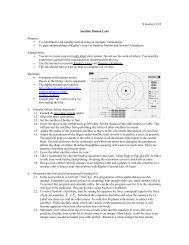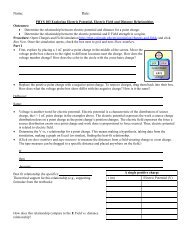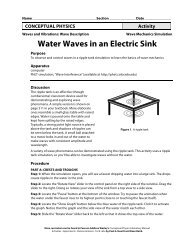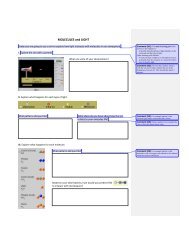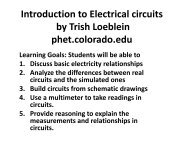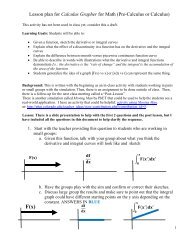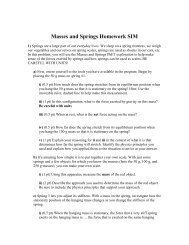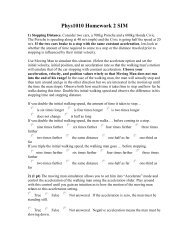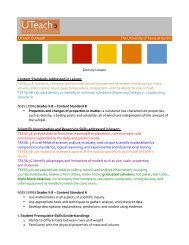Greased Lightning.pdf - PhET
Greased Lightning.pdf - PhET
Greased Lightning.pdf - PhET
You also want an ePaper? Increase the reach of your titles
YUMPU automatically turns print PDFs into web optimized ePapers that Google loves.
Name _________________________________ Section ______________ Date ______________<br />
CONCEPTUAL PHYSICS<br />
Tech Lab<br />
Electrostatics: Charging<br />
Carpet Shock Puzzle Simulation<br />
<strong>Greased</strong> <strong>Lightning</strong><br />
Purpose<br />
To determine the likelihood of getting a “carpet shock” (based on controllable variables), and to<br />
avoid or produce such shocks under a series of challenging conditions<br />
Apparatus<br />
computer<br />
<strong>PhET</strong> simulation, “John Travoltage” (Note: Use the Java version at phet.colorado.edu; not the HTML5)<br />
Discussion<br />
When you walk across a carpet and touch a metal doorknob, you might feel a small shock. The<br />
friction between the different materials in your footwear and the carpet gives you a static charge.<br />
(Physicists call it a triboelectric charge, meaning a charge from frictional contact.) The metal<br />
doorknob is a conductor, so the excess charge on your body jumps to the knob rapidly, creating the<br />
spark. Your nerves are sensitive to electrical impulses, so you feel the shock.<br />
In the simulation, John Travoltage’s foot can be rubbed across a carpet so that his body collects<br />
charge. His arm can be rotated so that a spark will jump from his finger to the doorknob.<br />
[The scientific model was changed for the HTML5 version of this sim; this activity was written for the<br />
original Java version.]<br />
Procedure<br />
Step 1: Start the computer and allow it to complete its startup process.<br />
Step 2: Launch the <strong>PhET</strong> simulation, “John Travoltage.” If you need assistance, ask your instructor for<br />
help.<br />
Step 3: Rub John Travoltage’s foot back and forth against the carpet until a spark jumps from his<br />
finger to the doorknob.<br />
How does John Travoltage react when the spark jumps?<br />
Step 4: Explore the simulation.<br />
a. Move John Travoltage’s hand close to the doorknob, then rub his foot on the carpet again.<br />
Compared to the process you observed in Step 3, what happens differently this time?<br />
More curriculum can be found in Pearson Addison Wesley‘s Conceptual Physics Laboratory Manual:<br />
Activities · Experiments · Demonstrations · Tech Labs by Paul G. Hewitt and Dean Baird.
. How can you get the maximum charge built up on John Travoltage without producing a spark?<br />
c. Under what circumstances—if any—will a spark jump from John Travoltage’s foot to the<br />
doorknob? Why do you suppose this is (in terms of the physics involved)?<br />
Step 5: Meet the challenges.<br />
a. Rotate John Travoltage’s arm so that his finger is pointing directly at the doorknob. Carefully rub<br />
his foot against the carpet without producing a spark.<br />
What is the greatest number of charges you can get onto John Travoltage’s body? (How many small<br />
spherical charges can be collected on his body before a discharge occurs?)<br />
b. Produce the longest spark possible: the spark<br />
is between John’s hand pointing directly away<br />
from the knob and the doorknob, itself. (Hint:<br />
The correct procedure requires less than a<br />
minute to complete.)<br />
How did you do it?<br />
c. Sustain the longest spark possible. Now that you know how to initiate the longest spark,<br />
determine a method to sustain the spark for several seconds (at least 10 seconds).<br />
How did you do it?<br />
More curriculum can be found in Pearson Addison Wesley‘s Conceptual Physics Laboratory Manual:<br />
Activities · Experiments · Demonstrations · Tech Labs by Paul G. Hewitt and Dean Baird.
Summing Up<br />
1. Under which conditions is a spark most likely to jump between John Travoltage and the<br />
doorknob? Describe in terms of the amount of charge on his body and the distance between his<br />
hand and the doorknob.<br />
2. Consider two variable quantities: the amount of charge Q on John Travoltage’s body and the<br />
distance d from his finger to the doorknob. How do these quantities relate to the likelihood S of<br />
a spark jumping? (This is a rough approximation, not an exact equation.)<br />
___ S ~ Qd ___ S ~ Q/d ___S ~ d/Q ___ S ~ 1/(Qd)<br />
3. Write a statement that conveys what your expression in question 2 means.<br />
4. When John Travoltage’s hand is turned away from the knob, no spark will start. But in Step 5,<br />
you sustained a spark from that configuration. What does this say about the conductivity of air?<br />
More curriculum can be found in Pearson Addison Wesley‘s Conceptual Physics Laboratory Manual:<br />
Activities · Experiments · Demonstrations · Tech Labs by Paul G. Hewitt and Dean Baird.


